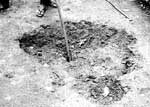Their lives are crumbling With huge cracks threatening the very foundations of their homes, villagers living in the Victoria Shear Zone in Matale have nowhere to go and feel that nobody cares about their plight Walls on the brink of collapse, ceilings about to cave in and people living in fear of their lives. This is the reality of life in the suburbs of Matale district. Some people are hopeful that remedial action would be taken, but others have lost faith in the system.
Villagers residing along a 10km stretch of what is known as the Victoria Shear Zone, between Naula and Ukuwela in Matale could be facing the danger of their homes caving in, as a result of a subsidence occurring. In other words, there is a lowering of a portion of the earth's crust in this area. This may be due to two factors, says National Buildings Research Organisation (NBRO) Geologist M.M.C.U.B. Moremada who is heading the Geological Hazards Study, Monitoring and Services Project that is studying the Matale district. One of the reasons for this occurance could be that the marble band beneath the soil was dissolving as a result of a chemical reaction with rain water over time, which in turn would leave cavities in the band. This could lead to the roofs of these cavities gradually weakening and collapsing thus resulting in the overlying rock and earth falling into this space, causing subsidence at the surface, Mr. Moremada said. The second factor could be that a major swelling of the soil was causing cracks because of the type of the soil which is expansive, he said. For instance these cracks which occur during the wet season, cause certain structural changes in the affected houses. However, during the dry season the gaps tend to close up again.
“Over 500 houses have already been affected in this area,” Mr. Moremada said. “All marble bands around the country aren’t dangerous. It is a combination of the weather, type of soil, water fluctuations, seismic activity and location of the band as a whole, that would come into play in these situations,” Mr. Moremada explained. He said the project office was set up in the premises of the Matale District Secretariat on June 8, and the three-year project now underway will be conducted in two primary stages. During the first phase the project will identify the people most at risk and compile a list of villagers who need to be evacuated immediately, he said. The team would also be collecting relevant geological and socio-economic data necessary for their next phase.
The second phase of the project will trace the
network of cavities, thus enabling them to draw up a Hazard Zonation
Map of the entire area, he said. The map will highlight all levels
of risk ranging from high to low respectively, thus making it an
essential guide for the local authorities to follow when approving
building sites. Furthermore, they hope to compile a set of guidelines/advisory
measures to follow with regard to the varied levels of risk. For
instance, persons in high risk areas should be evacuated, whereas
areas where the risk is moderate or low would undergo engineering
measures to minimise the risk, he said.
In a previous research conducted by NBRO, it had been recommended that four families be evacuated immediately, as they were at a high risk of a subsidence occurring, said Mr. Moremada. “We can only make recommendations, it’s up to the relevant local and state authorities to carry them out,” he said. However the affected people had their own story to tell. “We’re fed up with all the false promises givenby the local authorities. Even the media has highlighted our problems so many times but, nothing has been done ,” said Mrs. R.M.G. Badra Kumarihami who comes from one of the four families advised to evacuate their homes. There have been cracks in her house for the past 10-12 years, which have progressively widened over time. “Initially I didn’t complain about these cracks as I thought they were construction flaws and so we kept blaming the workmen,” she said. She said although the government had offered them an alternative plot of land in a nearby area it was in the middle of a jungle, cut away from the rest of civilisation, she said. “I would rather get buried alive here in my home, than be forced to move there into the middle of nowhere,” she said defiantly. “We were also told by an official in the Divisional Secretariat that the householders who were asked to evacuate would be entitled to Rs. 1,450,000 but, nothing has come our way. “The authorities have also instructed us to build a temporary room where we can sleep in the night but, that too has been stopped midway as we don’t have the money to finish it and nobody seems to be bothered to complete it,” she lamented. Yet another member of an affected family, W.G. Kusumalatha said that although they had built their house 15 years ago, no significant cracks had appeared till about four years back. There had been small fissures before, but they had begun widening only four years ago. Now a huge log has been placed in the middle of the hall to support the main beam of the roof as it could cave in any moment because of the cracks on the walls. Even the wall at the back of her house is being supported by a similar log, as it too has dangerously large cracks on it.
She had complained to the local authorities in 2004 and she too was showed the same place as Kumarihami, in Madawela about 16kms from where she lives now in Dunukewatte. Having two young grandchildren who will be starting school soon, and a widowed daughter and her son the sole bread winner living with her, she too finds it impractical to move to the jungle area . “However, if the authorities can offer us a proper place, where at least the basic facilities will be available, then we will move, because it is pointless just spending out of our own pockets on the countless repairs every time the walls or the floor cracks.”
|
|||||||||||
Copyright © 2006 Wijeya Newspapers
Ltd. All rights reserved. |




